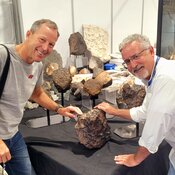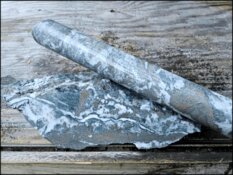Rick Rule: The answer to that is both. PGMs share the same investment characteristics as bullion. For centuries, PGMs have been a means of exchange and a store of value. Platinum and palladium enjoy the monetary attributes of bullion, just like gold and silver. But they also have industrial utility. Unlike gold and silver, which have large above-ground inventories, the above-ground, refined inventories of platinum and palladium have largely been used. There is less than 12 months' fabrication demand left in the world supply. Platinum and palladium go out a tailpipe, up a smokestack or get turned into high-value jewelry. Some people suggest that jewelry is still supply, but I know my wife does not consider her jewelry to be supply.
TMR: Other than the above-ground supply issues, how do PGMs differ from silver, which is considered more of an industrial metal?
RR: They are very different in that the above-ground supplies of silver are still fairly substantial and, in many people's minds, silver is a precious metal. Financial investors and individuals hoard substantial amounts of silver, particularly in South Asia, where silver is regarded as a store of wealth. Covert or hidden supplies do not exist in the PGM industry.
TMR: Are the issues that would make PGM prices rise related to supply-and-demand or to its bullion characteristics?
RR: Definitely supply-and-demand. While it will benefit from factors that move the bullion price, notably the deterioration of the U.S. dollar, the real case for an escalating PGM price is the supply structure. The price also relates to the extraordinary utility afforded by platinum and palladium, particularly with regard to catalytic conversion. There is a social equation: platinum versus smog. Despite reasonable progress in air quality in the Western world, there is consistent social demand for better air quality, which means more use of platinum and palladium.
TMR: Are there substitutes for platinum in catalytic converters?
RR: There is no substitute at an equivalent price point. The most directly applicable substitute is gold, which is also expensive but much less efficient in the catalytic conversion process. Theoretically, you could use nickel for some processes, but it is much less efficient.
The substantial air quality advances in the last 40 years are the consequence of small amounts of platinum. It takes only $200 worth of PGMs on a new vehicle to give us the air quality we enjoy now. If you doubled the price of PGMs, the cost of a new $27,000 vehicle, which is the median sticker price of a new car sold in California, would increase only marginally. The utility of platinum and palladium is so high that the price can go up.
TMR: Looking at the supply side, the British Geological Survey gave PGMs very high risk in terms of supply, partially because of political issues in South Africa and reserve issues in Russia. It predicts a possible 10% drop in world production. Is this a temporary supply issue?
RR: I think it is a temporary issue that will be solved by price. And while the British Geological Survey research is forward thinking, it is out of date. Because the industry does not earn its cost of capital, South African production has fallen 19% in the last six years. That is a critical statistic because South Africa contributes 70% of the world's new mine supplies of platinum and 30% of the new mine supplies of palladium. Production is already falling. While we have found small amounts in Canada, Brazil and Australia, three countries—Russia, Zimbabwe and South Africa—account for 90% of the world's new mine supply.
TMR: Is there geological evidence to support the potential for discoveries elsewhere?
RR: There will be a furor associated with increasing platinum and palladium prices and money will be made in exploration speculation in other places. Lots of platinum and palladium is still available in South Africa, Zimbabwe and Russia; it just requires a higher price. It is very likely that most of the platinum that we will be using 50 years from now will be found within the shadow of a headframe in existing locations. There are three discoveries on the horizon, two in South Africa and one in Russia, that will help us with platinum supply 10 years from now. The question is how to get from here to there.
TMR: Prices have been extraordinarily volatile in recent years. Will that continue, or will the increase be gradual?
RR: I expect a lot of volatility, mostly to the upside. The reason for this is simple: the industry does not earn its cost of capital. Look at South Africa, where the industry itself estimates it is $6 or $8 billion ($8B) behind in sustaining capital investments. As a result, the industry has not made the investments necessary to reach parts of the ore body that have not yet been accessed. This has manifested itself three ways. One, production cost goes up as a consequence of infrastructure-bound mines. Two, production declines. Finally, mine safety standards fall, which has manifested in increasing worker mortality in South Africa.
The South African platinum mining business is labor-intensive, not capital-intensive. And the working conditions and the pay workers receive are deplorable. Workers' wages have to go up, but cannot because the industry does not earn its cost of capital. Same thing for sustaining capital investments—there is no money. Finally, there is widespread political and social acceptance that the government's take by way of taxes, royalties and rents, has to go up.
If you take those three factors—deferred sustaining capital investments, increased worker compensation, and increased social take—the industry finds itself between a rock and a hard place.
TMR: What price would enable more capital investment and higher wages?
RR: We think a move in the platinum price from $1,650 to $2,700–3,000 would allow the South African platinum industry to earn its cost of capital, provided the increase in the social take was moderated.
The difficulty is that the demand for platinum is so high that the price will overshoot in the near term. Making the $6–8B in capital investments to maintain production in South Africa would take six years. These long lead times in a capital-intensive business underscore the likelihood of extraordinary price moves.
TMR: When might we reach or overshoot that potential price?
RR: I think it will happen in the next two years, given that we have used up the above-ground inventory and that we need to maintain the current auto fleet.
TMR: Once the price reaches $2,700 in the course of five years, would you expect the additional revenue to go back into South African mines? And would supply then increase to meet demand?
RR: I cannot guarantee that in five or six years, but I can guarantee that the problem will solve itself over 10 or 15 years, which suggests that this investment thesis has a lot of running room.
TMR: Given that the industry does not make its cost of capital, how are the mines staying open? Which are making enough money to continue production through this timeframe?
RR: The big players are Anglo Platinum Group (AMS:JSE), Impala Platinum Holdings Ltd. (IMP:JSE), Lonmin Plc (LMI:LSE) and the big Russian company, MMC Norilsk Nickel (GMKN:RTS).
Norilsk clearly earns its cost of capital. Its problem is that as you get deeper into the Norilsk ore body, the concentrations of palladium in the ore decline. Stalin opened these mines 80 years ago and the problem is technical: As you get deeper, the platinum and palladium run out. But Norilsk is profitable.
The other three—Angloplats, Implats and Lonmin—do not earn their cost of capital. Angloplats has some highly profitable operations, but they are dragged down by deep traditional narrow-vein operations, which cost money.
Sylvania Platinum Ltd. (SLP:LSE) is a small South African junior that produces probably 60 Koz/year. It is a tailing reprocessor, not a primary producer, but it earns its cost of capital. But it is a small company, probably $40–45M market capitalization. While not an efficient investment vehicle, it is a reasonable speculation.
Two companies on the horizon have made large discoveries in South Africa. Both have the right geometry and geology to be mechanized as opposed to labor intensive. Speculators who are willing to be involved in South African social turmoil and who believe the PGM thesis might want to look at Platinum Group Metals Ltd. (PTM:TSX; PLG:NYSE.MKT) and Ivanplats Ltd. (IVP:TSX). I own both, so I am talking my own book in this regard.
TMR: What are their market caps and what stage are they?
RR: Platinum Group Metals has a CA$600M market cap. Ivanplats is much larger, with a market cap near $3B. Because these companies are highly mechanized new builds, they would effectively be immune to challenges of sustaining capital and labor costs. However, they are not immune to South Africa's social instability. But when built, both deposits could generate substantial amounts of free cash.
Both are discoveries made over the last two or three years. Platinum Group Metals' project is under construction and should be producing in two years. Ivanplats has what is probably the most important PGM discovery since the Norilsk 80 years ago, but it will not be in production for about six years.
TMR: Is there still an investment opportunity with Norilsk in Russia, despite declining grade quality?
RR: Norilsk represents a very reasonable risk-reward tradeoff for people who are willing to participate in Russia and to accept the volatility in base metals prices. It is a jewel box of nickel, copper, cobalt, platinum and palladium.
It also has another deposit in Northern Siberia, remote even for Russia and far from any infrastructure. It is a nice deposit that will probably take $3B and 10 years to put into production.
TMR: Does Ivanplats have enough cash to bring the mines into production?
RR: No, not now. However, given the quality of its three world-class ore bodies and knowing Ivanplats is run by Robert Friedland, it should be able to raise the substantial capital needed.
TMR: Does Platinum Group Metals have the money in the bank to bring its mines to production?
RR: Yes. It raised the money in an ugly financing this last year. The debt package is in place.
TMR: How do these two compare to Sylvania?
RR: As a tailings reprocessor, Sylvania has very limited ongoing capital requirements. It has done some exploration, with mixed results. Assuming it does not continue with aggressive exploration, it will generate substantial, distributable cash relative to its market cap. I expect it will discontinue exploration and become a vehicle for distributing surplus cash from tailings reprocessing operations.
TMR: With Platinum Group Metals coming into production in the next three years, and Ivanplats right behind, will that satisfy the demand issues to the extent that the Norilsk project would not be needed?
RR: Not even close. That is the other part of the thesis. We do not have enough platinum to meet current Western demands, and demand will grow. Unless the Western economies drive off a cliff, we are due for a big rebound in automobile sales, which have been stalled since 2008. And when automobile demand increases, so does demand for catalytic converters.
Second, the Western world is clamoring for stricter emission standards for autos, refineries and chemical plants, all of which use platinum and palladium. Remember, it takes only $200 worth of platinum and palladium to give us the air quality we enjoy now in the Western world. But the real growth in the automobile market is in the frontier and emerging markets, in particular India and China.
Gasoline engines in China currently employ catalytic technology that uses less than 10% of the platinum and palladium loadings that Western vehicles do. As a partial consequence of that, air quality conditions in urban parts of China are deplorable. The Chinese government estimates that 500,000 Chinese die each year of cardiopulmonary illness as a consequence of very poor air quality standards. The Chinese government has proposed air quality standards over five years that would quintuple the loadings of platinum and palladium in gasoline engines in China.
The Chinese government has also asked the China National Offshore Oil Corp. to begin selling diesel at Western quality with regard to sulfur loadings that would permit the introduction of catalytic converters on diesel engines in China. These two things would represent an absolute sea change in platinum demand in a market that's already undersupplied.
TMR: If just one year of reserves remains, and demand is growing, someone will not get the metals it needs. Who would that be?
RR: I believe the major automobile manufacturers that have the balance sheet flexibility—Toyota and Mercedes-Benz, for example—will become hoarders this year and next. I suspect the auto manufacturers or the fabricators that lack the balance sheets to hoard platinum will be left out in the cold.
That is why we established the Sprott Physical Platinum and Palladium Trust. We raised $280M last December and bought equal dollar amounts' worth of platinum and palladium.
TMR: Technology and innovation seem to balance out when you have a sharp gap between supply and demand. Could technology develop an alternative to the traditional catalytic converter that does not rely on PGMs?
RR: I welcome that kind of development, but right now, platinum and palladium are so cheap relative to the effective job they do that there is no incentive for new technology. Over time, the markets will work in the platinum and palladium sector. The price will be high enough and people will be scared enough that we will find more of the metals. The problems in Russia, South Africa and Zimbabwe will sort themselves out over the next 10 or 15 years.
This thesis plays out in a 1–5-year timeframe, and I do not see anything that would derail it, with the exception of a 2008-style liquidity event that destroys Western demand.
TMR: Would the average investor be better off investing in the metal through the trust or equities?
RR: Whether you buy physical platinum and palladium, an exchange-traded fund (ETF) or the trust, if you think the price of the metal will rise, buy the metal. We chose a trust instead of an ETF because, assuming that the thesis is right, the Sprott Physical Platinum Trust is taxed at the capital gains tax rate while ETFs or physical metals are taxed at the collectible or income rate.
You buy a company because you believe something intrinsic in that company will make its share price go up. In that thesis, the commodity price increase is the icing on the cake after taking financing and operational risk. You are taking greater risk than just buying the metal, and you should get a greater return.
I believe that a rising price will float all ships, but it will float them unequally. There is risk that if the price increase is deferred, some companies will not survive until the price does rise. Thus, people who are speculatively inclined and willing to buy the companies should only buy companies that would survive at the current price point, in other words, companies in the lowest cost quartile on a global basis. Those speculative companies would be Norilsk, Platinum Group Metals and Ivanplats. Sylvania, as well, but that is really not for the faint of heart.
TMR: Are there any other perspectives on the PGMs our readers should know?
RR: I would urge your readers, first of all, to regard PGMs as bullion and to own them for the same reasons they own any bullion. But they should understand that the supply-and-demand thesis for platinum and palladium is compelling and simple: The price must rise because the industry does not earn its cost of capital, and the price can rise due to the incredible utility the metals deliver.
TMR: Putting on my skeptical hat, is that the same argument made for uranium back in 2008?
RR: The argument was made in 2008, and I made the argument for uranium in 2000, when we made the stuff for $20 per pound ($20/lb). We sold it for $8/lb and tried to make up the lost $12/lb on volume. The price of uranium had to go up or there would not be any more uranium. And the price of uranium could go up because the utility it afforded to users was the same. When its price rose to $100/lb, the industry was making it for $40/lb, a $60/lb margin.
After the thesis had been proven, everybody signed on to it despite the fact that the thesis was no longer true; the validation had invalidated the thesis. People will sign on to the platinum and palladium thesis when the price of platinum goes through $2,600 or $2,700/oz, when the price does not have to go up anymore, just like they did in the uranium business.
TMR: Being contrarian, getting into the thesis early on and riding it rather than waiting for it to be proven is what works.
RR: Absolutely, and I expect it to be true in platinum and palladium.
TMR: Rick, thank you for your time and your insights.
Rick Rule, founder and chairman of Sprott Global Resource Investments Ltd., began his career in the securities business in 1974. He is a leading American retail broker specializing in mining, energy, water utilities, forest products and agriculture. His company has built a national reputation on taking advantage of global opportunities in the oil and gas, mining, alternative energy, agriculture, forestry and water industries.
Want to read more Metals Report interviews like this? Sign up for our free e-newsletter, and you'll learn when new articles have been published. To see a list of recent interviews with industry analysts and commentators, visit our Metals Report homepage.
DISCLOSURE:
1) Karen Roche conducted this interview for The Metals Report and provides services to The Metals Report as an employee. She or her family own shares of the following companies mentioned in this interview: None.
2) The following companies mentioned in the interview are sponsors of The Metals Report: None. Streetwise Reports does not accept stock in exchange for its services or as sponsorship payment.
3) Rick Rule: I or my family own shares of the following companies mentioned in this interview: Sylvania Platinum Ltd., Platinum Group Metals Ltd. and Ivanplats Ltd. I personally am or my family is paid by the following companies mentioned in this interview: None. My company has a financial relationship with the following companies mentioned in this interview: None. I was not paid by Streetwise Reports for participating in this interview. Comments and opinions expressed are my own comments and opinions. I had the opportunity to review the interview for accuracy as of the date of the interview and am responsible for the content of the interview.
4) Interviews are edited for clarity. Streetwise Reports does not make editorial comments or change experts' statements without their consent.
5) The interview does not constitute investment advice. Each reader is encouraged to consult with his or her individual financial professional and any action a reader takes as a result of information presented here is his or her own responsibility. By opening this page, each reader accepts and agrees to Streetwise Reports' terms of use and full legal disclaimer.
6) From time to time, Streetwise Reports LLC and its directors, officers, employees or members of their families, as well as persons interviewed for articles and interviews on the site, may have a long or short position in securities mentioned and may make purchases and/or sales of those securities in the open market or otherwise.













































